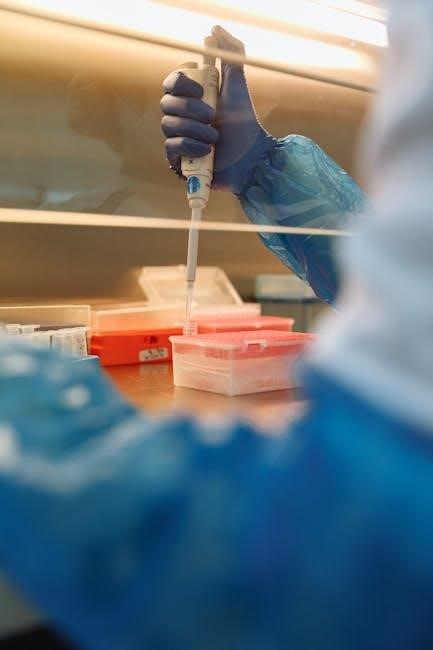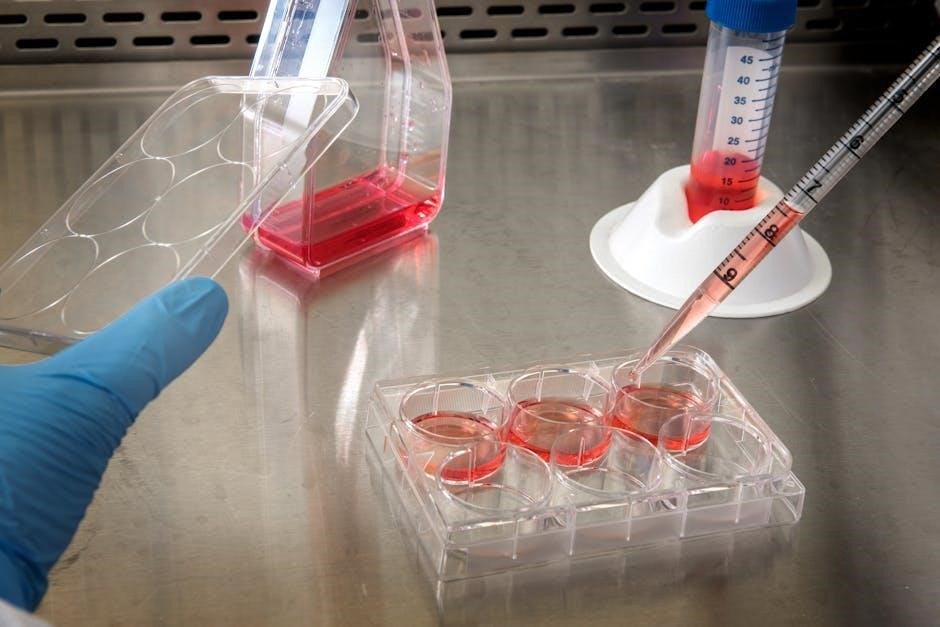AP Biology Unit 1 Test Multiple Choice PDF: Comprehensive Overview
This document provides a detailed review of key concepts, offering 34 multiple-choice questions to assess understanding of biology fundamentals, including molecular structures, cellular processes, and energy dynamics.

The AP Biology Unit 1 test is a foundational assessment covering key biological concepts, including molecular structures, cellular processes, and energy dynamics; It features 34 multiple-choice questions designed to evaluate understanding of essential topics. The exam emphasizes critical thinking and scientific reasoning, aligning with the curriculum’s focus on experimental design and data interpretation. Practice exams and study resources are widely available, offering students the opportunity to refine their test-taking skills and master core biology principles effectively.
Structure of the AP Biology Unit 1 Exam
The AP Biology Unit 1 exam consists of multiple-choice questions and grid-in questions, assessing understanding of biological concepts. The test includes 53 multiple-choice questions and 5 grid-in questions, with a total time of 90 minutes. Part A contains 63 multiple-choice questions, while Part B includes 6 grid-in questions. This structure evaluates both knowledge recall and analytical skills, requiring students to interpret data, evaluate experiments, and connect concepts across topics. Understanding the exam layout helps students allocate time effectively and approach each question type strategically.
Importance of Multiple-Choice Questions in AP Biology
Multiple-choice questions (MCQs) in AP Biology are crucial for assessing knowledge recall and critical thinking. They evaluate students’ ability to interpret complex biological concepts, experiments, and data. MCQs help identify gaps in understanding, allowing targeted study. Regular practice with MCQs improves test-taking skills, such as time management and eliminating incorrect answers. They also simulate exam conditions, reducing anxiety and enhancing performance. Utilizing MCQ resources, like practice exams, is essential for mastering the exam format and achieving success in AP Biology Unit 1.

Key Topics Covered in AP Biology Unit 1
Unit 1 covers the nature of science, biological molecules, cell structure, membrane transport, energy dynamics, photosynthesis, respiration, and genetics, forming the foundation of AP Biology.

1.1. The Nature of Science and Biology
This section introduces the fundamental principles of scientific inquiry and biology, emphasizing empirical evidence, the scientific method, and the importance of reproducibility. Students explore how biology integrates with other sciences to understand life’s complexity. Key concepts include the structure of atoms, molecules, and cells, setting the stage for advanced topics like genetics and biotechnology. The focus is on developing critical thinking skills to analyze biological phenomena and evaluate experimental data, fostering a deep appreciation for the scientific process.
1.2. Biological Molecules: Structure and Function
This section delves into the essential biological molecules, including carbohydrates, proteins, lipids, and nucleic acids. Students learn about their structures, functions, and roles in cellular processes. Key topics include the composition of biomolecules, such as the presence of phosphate groups, ribose, and uracil in RNA, and the formation of polar covalent bonds in molecules like H2O. Understanding these molecules is crucial for grasping how cells operate and how life sustains itself. Multiple-choice questions in this area test the ability to identify and describe these biomolecules accurately.
1.3. Cell Structure and Organization
This section explores the intricate structures within cells, focusing on organelles and their specialized functions. Key topics include the roles of the nucleus, mitochondria, ribosomes, and the endoplasmic reticulum in cellular processes. Students learn about membrane-bound organelles, non-membrane structures, and how cells maintain organization through the cytoskeleton. Multiple-choice questions test knowledge of organelle functions, such as protein synthesis and energy production, as well as the importance of cellular compartmentalization in maintaining homeostasis and efficiency.
1.4. Membrane Transport and Cellular Communication
This section covers the mechanisms by which cells transport materials across membranes, including passive transport (diffusion, osmosis) and active transport. It also explores how cells communicate through signaling molecules, such as hormones and neurotransmitters. Key concepts include the role of ion channels, carrier proteins, and vesicle transport. Multiple-choice questions test understanding of transport types, concentration gradients, and the importance of communication in coordinating cellular activities and maintaining tissue function. Students must differentiate between various transport mechanisms and their energy requirements.
1.5. Energy Dynamics in Living Organisms
This section delves into how organisms acquire, store, and utilize energy. Key topics include ATP as the primary energy currency, metabolic pathways like glycolysis, the Krebs cycle, and oxidative phosphorylation. The laws of thermodynamics and their biological implications are also explored. Multiple-choice questions assess understanding of energy transformations, efficiency, and the role of enzymes in metabolic processes. Students must apply knowledge of energy flow, cellular respiration, and photosynthesis to solve problems, demonstrating comprehension of energy dynamics in living systems.
1.6. Photosynthesis and Respiration
Photosynthesis and cellular respiration are pivotal processes in energy conversion. Photosynthesis involves light-dependent reactions, the Calvin cycle, and the production of glucose. Respiration includes glycolysis, the Krebs cycle, and oxidative phosphorylation, yielding ATP. Multiple-choice questions test understanding of these pathways, including the role of chloroplasts and mitochondria, energy efficiency, and the interplay of oxygen and carbon dioxide. Students must differentiate between light-dependent and light-independent reactions and explain the aerobic vs. anaerobic processes, demonstrating mastery of energy transformation in living organisms.
1.7. Genetics and Molecular Biology Basics
Genetics and molecular biology form the foundation of understanding heredity and DNA processes. Topics include DNA structure, replication, and repair, as well as transcription and translation mechanisms. Questions assess knowledge of Mendelian genetics, Punnett squares, and gene expression regulation. Key concepts like mutations, genetic drift, and the central dogma are emphasized. Multiple-choice questions also explore molecular tools, such as PCR and CRISPR, and their applications. Students must demonstrate an understanding of how genetic information is passed on and expressed at the molecular level, connecting genotype to phenotype in various organisms.

Preparing for the AP Biology Unit 1 Test
Effective preparation involves utilizing practice exams, study guides, and active learning techniques. Focus on understanding key concepts, managing time efficiently, and reviewing answers to improve accuracy.
2.1. Understanding the Test Format
The AP Biology Unit 1 test includes 53 multiple-choice questions and 5 grid-in questions, totaling 90 minutes. Section I is divided into Part A (63 multiple-choice) and Part B (6 grid-in). Understanding this format helps students allocate time efficiently and focus on high-weight areas. Familiarizing oneself with question types, such as interpreting data or evaluating experiments, is crucial for strategic preparation. Practicing under timed conditions and reviewing answer formats ensures readiness for test day. This knowledge aids in minimizing errors and maximizing scores. Proper time management and format awareness are key to success in the exam.
2.2. Effective Study Strategies for Multiple-Choice Questions
Mastering multiple-choice questions requires a strategic approach. Focus on understanding core concepts rather than memorizing facts. Utilize active learning techniques, such as creating flashcards for key terms and concepts. Practice with past exams to familiarize yourself with question formats and timings. Learn to eliminate incorrect answers to increase the chances of selecting the right one. Stay calm and read questions carefully to avoid misunderstandings. Regular review of challenging topics and consistent practice with sample questions will enhance confidence and accuracy. Leveraging video tutorials and study guides can also provide clarity on complex subjects.
2.3. Time Management During the Exam
Effective time management is crucial for success. Allocate 1-2 minutes per multiple-choice question, ensuring enough time for all questions. Skip difficult ones initially and return later; Budget 5-10 minutes for review to check answers and correct errors. Practice timing during study sessions to build speed and accuracy. Stay focused and avoid wasting time on single questions. Prioritize questions with higher confidence first to secure points. Maintaining a steady pace helps manage stress and ensures all sections are attempted.
2.4. Utilizing Practice Exams for Better Preparation
Practice exams are invaluable for mastering the AP Biology Unit 1 test format. They simulate real test conditions, helping you assess strengths and weaknesses. Complete full-length exams to build stamina and time management skills. Review answers to understand mistakes and improve understanding of key concepts. Use the results to focus study efforts on challenging areas. Regular practice exams enhance familiarity with question types and boost confidence, ensuring readiness for the actual test day. They provide a comprehensive assessment of knowledge retention and application abilities.

AP Biology Unit 1 Multiple-Choice Question Analysis
This section examines common question types, patterns, and strategies to tackle challenging problems. It emphasizes understanding the scoring system and refining answer elimination techniques for better performance.
3.1. Common Question Types and Patterns
Questions often test understanding of biological processes, structure-function relationships, and experimental data interpretation. Patterns include identifying molecules, comparing concepts, and applying knowledge to scenarios. Students should recognize these types to strategize effectively.
3.2. Strategies for Eliminating Incorrect Answers
Eliminate answers that contradict biological principles or contain obvious errors. Use process of elimination by identifying distractors and focusing on plausible choices. Understanding common misconceptions helps avoid traps. Prioritize questions with clear answers to manage time effectively.
3.3. Approaches to Tackling Difficult Questions
For challenging questions, break down complex terms and analyze stem components. Identify key biological concepts embedded within the question. Eliminate clearly incorrect options first, then make educated guesses from remaining choices. Use prior knowledge of laboratory experiments and textbook examples to inform decisions. If stuck, consider answering later and return after completing easier questions to manage time effectively and reduce stress during the exam.
3.4. Understanding the Scoring System
The AP Biology Unit 1 multiple-choice section awards 1 point for each correct answer, with no points deducted for incorrect or blank answers. This encourages strategic guessing, as unanswered questions neither harm nor benefit the score. The total score is calculated based on the number of correct responses, providing a clear measure of mastery. Understanding this system helps students optimize their exam strategy, focusing on maximizing correct answers while avoiding unnecessary time spent on uncertain questions. This approach ensures a fair and straightforward evaluation process.

Resources for AP Biology Unit 1 Test Preparation
Utilize textbooks, online platforms, flashcards, and video tutorials to enhance preparation. Practice exams and study guides provide comprehensive review, aiding in mastering key concepts and test-taking strategies effectively.
4.1. Recommended Textbooks and Study Guides
For AP Biology Unit 1 preparation, Campbell Biology by Jane B. Reece is a highly recommended textbook, offering detailed explanations of biological concepts. Additionally, study guides like AP Biology: A Study Guide provide focused review materials. Online resources, such as practice exams from College Board, are invaluable for familiarizing yourself with the test format. Flashcards and concept maps, available on platforms like Quizlet, help reinforce key terms and processes. Utilizing these tools ensures a comprehensive understanding of topics like biomolecules, cell structure, and energy dynamics, aiding in effective test preparation.
4.2. Online Platforms for Practice Tests
Online platforms like College Board and Khan Academy offer comprehensive practice tests for AP Biology Unit 1. These platforms provide multiple-choice questions, interactive exercises, and detailed explanations to help students assess their knowledge. Additionally, websites such as Quizlet and Varsity Tutors feature flashcards and practice exams that simulate real test conditions. Utilizing these resources allows students to identify weak areas, improve time management, and familiarize themselves with the exam format. Regular practice on these platforms enhances confidence and readiness for the actual test.
4.3. Flashcards and Concept Maps for Key Terms
Flashcards are an effective tool for memorizing key terms and concepts in AP Biology Unit 1. Platforms like Quizlet and Anki offer pre-made decks and allow customization. Concept maps, such as those created with MindMeister or Coggle, visually organize information, helping students connect ideas and understand relationships between topics. These resources are particularly useful for reviewing biological molecules, cell structures, and energy processes. Regular use of flashcards and concept maps improves retention and clarity, ensuring students are well-prepared for multiple-choice questions on the exam.
4.4. Video Tutorials and Lecture Resources
Video tutorials and lecture resources provide engaging and accessible learning for AP Biology Unit 1. Platforms like Khan Academy and Crash Course offer detailed explanations of complex topics, such as cellular transport and photosynthesis. YouTube channels like 3Blue1Brown and Amor Sciendi present concepts visually, aiding comprehension. Additionally, recorded lectures from MIT OpenCourseWare and Coursera cover foundational biology, supplementing textbook material. These resources are invaluable for reinforcing understanding and preparing for multiple-choice questions on the Unit 1 exam.

Common Mistakes to Avoid in the AP Biology Unit 1 Test
- Misunderstanding key biological concepts like cellular transport and photosynthesis.
- Poor time management leading to incomplete answers.
- Not reviewing answers for accuracy before submission.
- Overcomplicating simple questions, leading to incorrect choices.
5.1. Misunderstanding Key Concepts
One of the most common mistakes in the AP Biology Unit 1 test is misunderstanding fundamental concepts, such as cellular transport mechanisms or energy dynamics. Students often confuse passive transport with active transport or misinterpret the roles of photosynthesis and respiration. Additionally, misconceptions about biological molecules, like the difference between RNA and DNA, can lead to incorrect answers. It’s crucial to thoroughly review these topics and seek clarification on any confusing material. Practicing with multiple-choice questions can help identify and address these misunderstandings early in the preparation process.
5.2. Time Management Errors
Many students make the mistake of poor time management during the AP Biology Unit 1 test, leading to rushed or unanswered questions. With 90 minutes for 53 multiple-choice questions, allocating about 1.5 minutes per question is essential. Some spend too much time on complex questions, leaving easier ones unanswered. Practice exams can help improve pacing and ensure all questions are attempted. Skimming through the test to answer simpler questions first is a effective strategy to avoid running out of time. Proper time allocation is key to maximizing scores.
5.3. Not Reviewing Answers
Failing to review answers is a common mistake that can significantly impact test performance. Students often skip this step due to time constraints or overconfidence. Reviewing answers allows for the correction of careless errors, such as misreading questions or selecting the wrong option. Additionally, it provides an opportunity to revisit ambiguous questions and make more informed choices. Regularly practicing with sample tests can foster this habit and improve overall accuracy. Taking a few minutes to review ensures that no avoidable mistakes are left unaddressed, potentially boosting the final score.
5.4. Overcomplicating Simple Questions
Overcomplicating simple questions is a common pitfall that can lead to incorrect answers and wasted time. Students often overthink straightforward questions, doubting their initial instincts and second-guessing themselves. This tends to happen when individuals are under pressure or lack confidence. It’s essential to trust your knowledge and avoid overanalyzing. Practice with multiple-choice questions helps build familiarity and reduces the likelihood of this mistake. Simplify your approach by focusing on key terms and eliminating clearly incorrect options before making a decision. This strategy ensures clarity and efficiency during the exam. Staying calm and decisive is key to success.

Scientific Reasoning and Experimental Design in Unit 1
Mastering scientific reasoning and experimental design is crucial for Unit 1. Students must interpret data, design valid experiments, and evaluate scientific claims to apply biological concepts effectively.
6.1. Interpreting Data and Graphs
Interpreting data and graphs is a critical skill in AP Biology. Students analyze experimental results, identify trends, and draw conclusions. Practice exams often include questions requiring the interpretation of charts and tables. For example, identifying independent and dependent variables, understanding axes labels, and calculating rates or slopes. This skill assesses the ability to translate visual data into meaningful biological insights. Regular practice with sample graphs helps build confidence and accuracy in data interpretation, a key component of scientific reasoning in biology.
6.2. Designing Valid Experiments
Designing valid experiments is a cornerstone of scientific inquiry in AP Biology. Students must understand how to formulate hypotheses, identify variables, and establish controls. Practice exams often present scenarios requiring the evaluation of experimental designs. Key considerations include ensuring reliability, minimizing bias, and validating results. By analyzing sample experiments, students learn to critically assess the methodology and outcomes. Mastery of this skill is essential for applying scientific principles to real-world biological questions, fostering a deeper understanding of experimental design and its role in advancing knowledge.
6.3. Evaluating Scientific Claims
Evaluating scientific claims requires critical analysis of evidence, logical reasoning, and an understanding of experimental design. Students must assess whether claims are supported by data, peer-reviewed research, and replication. Practice exams often include questions that test the ability to identify biases, flawed methodologies, or unsupported conclusions. By refining these skills, students develop a deeper understanding of scientific validity and learn to distinguish credible research from less reliable sources. This skill is essential for interpreting data and applying biological principles to real-world scenarios effectively.
6.4. Connecting Concepts Across Topics
Connecting concepts across topics is crucial for understanding complex biological systems. In Unit 1, students learn to integrate knowledge of biological molecules, cellular processes, and energy dynamics. This integration helps in synthesizing information and applying it to real-world scenarios. Practice exams often require linking concepts, such as how membrane transport relates to cellular communication or energy production. Students should focus on recognizing these connections to answer questions effectively. By mastering this skill, they develop a holistic understanding of biology, enabling them to tackle challenging questions with confidence and accuracy during the test.

Final Tips for Success on the AP Biology Unit 1 Test
Stay calm, use active learning techniques, and practice regularly. Seek help when needed, and maintain confidence. These strategies ensure a strong performance on test day.
7.1. Staying Calm and Focused
Remaining calm during the test is crucial for clear thinking. Practice deep breathing exercises beforehand to manage anxiety. Maintain focus by reading each question carefully and eliminating distractors. A composed mindset allows for better problem-solving and logical reasoning, ensuring you approach each question methodically. Regular practice helps build confidence, reducing test-day nerves. Staying positive and visualizing success can also enhance performance. Remember, a calm and focused state is key to maximizing your potential and achieving the desired results on the AP Biology Unit 1 test.
7.2. Leveraging Active Learning Techniques
Active learning enhances engagement and retention of biological concepts. Techniques like self-testing, summarizing notes, and teaching others improve understanding. Utilize flashcards for key terms and concept maps to visualize relationships between ideas. Engage in group discussions to clarify doubts and explore complex topics collaboratively. Regularly reviewing and practicing past multiple-choice questions sharpens analytical skills. These strategies foster a deeper grasp of the material, enabling you to approach the test with confidence and tackle challenging questions effectively. Active learning is essential for mastering the content of the AP Biology Unit 1 test.
7.3. Regular Review and Practice
Consistent review and practice are crucial for excelling in the AP Biology Unit 1 test. Set aside time daily to revisit notes, textbook chapters, and online resources. Use practice exams to simulate test conditions, helping you manage time and reduce anxiety. Focus on weak areas identified through practice and reinforce them with additional study materials. Regular practice strengthens your ability to apply concepts to multiple-choice questions, ensuring a solid foundation for test day. Make practice a habit to build confidence and mastery of the subject matter.
7.4. Seeking Help When Needed
Recognizing when you need assistance is a key part of successful preparation for the AP Biology Unit 1 test. Don’t hesitate to ask teachers, peers, or tutors for clarification on challenging concepts. Join study groups or online forums to discuss difficult topics and gain new insights. Utilize resources like textbooks, online tutorials, and practice exams to reinforce your understanding. Seeking help early ensures you address weaknesses before the exam, allowing you to approach the test with confidence and a stronger grasp of the material.
Mastering the AP Biology Unit 1 requires diligent study and practice. Use available resources effectively, stay focused, and approach the test with confidence to ensure success.
8.1. Summarizing Key Takeaways
The AP Biology Unit 1 test multiple-choice PDF is a valuable resource for assessing understanding of fundamental concepts like biological molecules, cell structure, and energy dynamics. Regular practice with sample questions enhances test-taking skills and identifies knowledge gaps. Utilizing study guides, online platforms, and flashcards can reinforce learning. Additionally, reviewing experimental design and scientific reasoning strategies is crucial for success. By staying organized and focused, students can approach the exam with confidence and achieve their goals. Consistent effort and effective time management are key to excelling in the test.
8.2. Encouragement for Continuous Improvement
Embracing a growth mindset is essential for excelling in AP Biology. Each practice test and study session is an opportunity to refine knowledge and strategies. By identifying areas for improvement and seeking resources, students can gradually master complex concepts. Celebrating small achievements and staying persistent will build confidence. Continuous learning and adaptability are key to long-term success in both the exam and future academic pursuits. Remember, consistent effort and dedication lead to significant progress over time.
8.3. Final Motivation for Test Day
Test day is your moment to shine! Trust the effort you’ve put into studying and practicing. Approach each question with confidence, knowing you’ve prepared thoroughly. Stay calm, read carefully, and showcase your understanding. Remember, it’s not just about the score—it’s about demonstrating your mastery of biology concepts. Take a deep breath, stay focused, and give it your all. You’ve got this! Your hard work and dedication will pay off, so go in there and make it count. Good luck!
